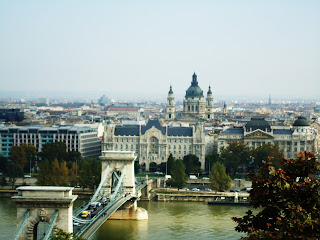We did a free walking tour in the city on Friday morning and I definitely recommend. We got to see the major highlights in the city and got recommendations for nightlife and restaurants, all for free. At the start of the tour, the guide pointed out the many different architectural styles-Classical, Gothic, Renaissance, Baroque and Art Nouveau, that result from their unique history. We got to see the Parliament building, the bridge connecting Buda and Pest, and the Basilica on the Pest side. We walked to the Buda Side where the Royal Palace grounds are. Security is so lax and the threats so small in Hungary that you were able to walk right past the President's house, with no security outside. In Holy Trinity square we saw a fantastic church with intricate colorful tiled roofing. There was the most amazing little castle close to the Palace grounds that reminded me a lot of a Disney castle :). There were underground labyrinths on the Buda side, we didn't get a chance to go inside any of them but we got to see the entrance. Also on the Buda Side was a statute that the Communist built in honor of the unification of the Buda and Pest sides. The Buda side is much hillier and is known for being pricey, whereas the Pest side is known for it's nightlife and more affordable prices. Budapest is famous for it's bath houses with hot springs, I was disappointed we didn't have time to go check one out. After finishing up the walking tour the guide took up to a canteen style restaurant called "12 markets" which traditional Hungarian food. I got vegetable soup and gnocchi with mushroom sauce, it was good but nothing special, once again because most Hungarian specialties contain meat so my options were limited.
Later in the afternoon we did the free Communist walking tour. The tour was interesting but I recommend the first tour over this one. The guide started the tour by giving us a brief run down of the history of communism in Hungary. She said that in the 50's and early 60's it was a depressive state and if you were to go against the idea of communism in any way you would be tortured or killed. The communist had social housing projects where they built extremely small 1-2 bedroom apartments, the idea was that people should all be working and shouldn't be spending much time in their apartments anyways. People would become trapped into being 'informers', and once you became involved in communism, you couldn't escape. In the 70's the idea of "soft communism" developed and people weren't as repressed, shortly after, people were finally allowed to travel. Some people received a red passport which meant they could travel to other communist controls, and others received a blue passport which meant they could travel anywhere, this was a monumental event for Hungarians. In 1989, Hungary was no longer a communist country, however to this day the long lasting effects of communism are ever present in the country. The guide was telling us that the health care system is extremely corrupt. Everyone should have access to health care and equal benefits. This isn't the case- because doctors are paid so little they will take bribes from people that can afford to pay more in exchange for better health care services. If doctors weren't to take bribes, they would be too poor to remain in Hungary and Hungarian health care providers would dwindle even more. At the end of the tour the guide showed us samples of the red and blue passports and pictures of Budapest during communist rule. It was a great day all in all and I felt like I got to learn an extensive amount about Hungary in the short time I was there.
We went out to a fun bar named Szempla with the people from our hostel later that night, I definitely recommend the bar. It was partially indoors and partially outdoors, full of tourists and locals, and it had a great atmosphere and music. And the next morning the journey continued to Vienna, Austria!
Basilica on the Pest side, close to the city center
Castle on the Buda side near the Royal Palace






No comments:
Post a Comment